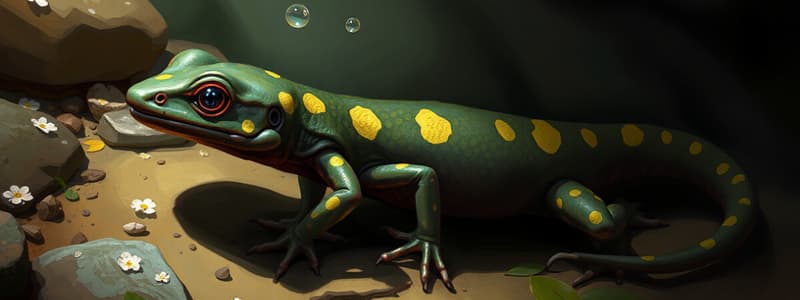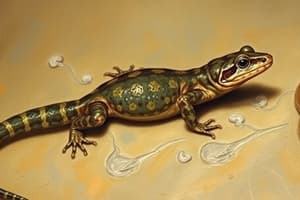Podcast
Questions and Answers
What is the scientific name of Jefferson's Salamander?
What is the scientific name of Jefferson's Salamander?
- Ambystoma jeffersonianum (correct)
- Ambystoma tigrinum
- Ambystoma opacum
- Ambystoma maculatum
What is the scientific name of Spotted Salamander?
What is the scientific name of Spotted Salamander?
- Ambystoma jeffersonianum
- Ambystoma opacum
- Ambystoma maculatum (correct)
- Ambystoma tigrinum
What is the scientific name of Marbled Salamander?
What is the scientific name of Marbled Salamander?
- Ambystoma tigrinum
- Ambystoma jeffersonianum
- Ambystoma opacum (correct)
- Ambystoma maculatum
What is the scientific name of Eastern Tiger Salamander?
What is the scientific name of Eastern Tiger Salamander?
What is the scientific name of Green Salamander?
What is the scientific name of Green Salamander?
What is the scientific name of Eastern Hellbender?
What is the scientific name of Eastern Hellbender?
What is the scientific name of Northern Dusky Salamander?
What is the scientific name of Northern Dusky Salamander?
What is the scientific name of Seal Salamander?
What is the scientific name of Seal Salamander?
What is the scientific name of Northern Two-lined Salamander?
What is the scientific name of Northern Two-lined Salamander?
What is the scientific name of Long-tailed Salamander?
What is the scientific name of Long-tailed Salamander?
What is the scientific name of Northern Spring Salamander?
What is the scientific name of Northern Spring Salamander?
What is the scientific name of Four toed Salamander?
What is the scientific name of Four toed Salamander?
What is the scientific name of Common Mudpuppy?
What is the scientific name of Common Mudpuppy?
What is the scientific name of Red Spotted Newt?
What is the scientific name of Red Spotted Newt?
What is the scientific name of Eastern Red-backed Salamander?
What is the scientific name of Eastern Red-backed Salamander?
What is the scientific name of Northern Ravine Salamander?
What is the scientific name of Northern Ravine Salamander?
What is the scientific name of Northern Slimy Salamander?
What is the scientific name of Northern Slimy Salamander?
What is the scientific name of Valley & Ridge Salamander?
What is the scientific name of Valley & Ridge Salamander?
What is the scientific name of Wehrle's Salamander?
What is the scientific name of Wehrle's Salamander?
What is the scientific name of Eastern Mud Salamander?
What is the scientific name of Eastern Mud Salamander?
What is the scientific name of Northern Red Salamander?
What is the scientific name of Northern Red Salamander?
Flashcards are hidden until you start studying
Study Notes
Jefferson's Salamander (Ambystoma jeffersonianum)
- Notable for its distinct coloring and habitats, primarily found in moist, wooded areas.
- Breeds in temporary ponds during early spring.
Spotted Salamander (Ambystoma maculatum)
- Recognized by yellow or white spots on a dark background.
- Habitats include deciduous and mixed forests, with moist conditions favored for breeding.
Marbled Salamander (Ambystoma opacum)
- Distinctive for its bold black and white marbling pattern.
- Uniquely breeds in the fall, often laying eggs in dry vernal pools.
Eastern Tiger Salamander (Ambystoma tigrinum)
- Recognized by its tiger-stripe pattern and large size.
- Prefers a variety of habitats including grasslands and woodlands.
Green Salamander (Aneides aeneus)
- Notable for its vibrant green coloration, often found on cliffs or in rocky outcrops.
- Prefers moist environments and is an arboreal species.
Eastern Hellbender (Cryptobranchus alleganiensis)
- The largest salamander in North America, can exceed 29 inches in length.
- Primarily aquatic, inhabiting clean, fast-moving streams and rivers.
Northern Dusky Salamander (Desmognathus fuscus fuscus)
- Prefers cool, moist habitats like stream banks and under rocks.
- Characterized by a robust body and keeled tail.
Seal Salamander (Desmognathus monticola)
- Found in high elevation forests and among rocky streams.
- Features a dark body with light spots, adapted to cold-water environments.
Allegheny Mountain Dusky Salamander (Desmognathus ochrophaeus)
- Endemic to the Appalachians, preferring cool, humid climates.
- Similar in appearance to the Northern Dusky but distinguished by habitat preferences.
Northern Two-lined Salamander (Eurycea bislineata)
- Characterized by two distinct lines running along its body.
- Commonly found in a variety of moist habitats including forests and streams.
Long-tailed Salamander (Eurycea longicauda)
- Known for its long tail relative to body size and yellow to orange coloration.
- Typically found in leaf litter and under rocks in damp areas.
Northern Spring Salamander (Gyrinophilus p.porphyriticus)
- Features a robust body with a striking orange or pink coloration.
- Prefers clean, cool springs and streams for habitat.
Four-toed Salamander (Hemidactylium scutatum)
- Unique for having four toes on its hind feet.
- Inhabits wet habitats, particularly around vernal pools.
Common Mudpuppy (Necturus maculosus)
- A fully aquatic salamander retained external gills throughout its life.
- Lives in lakes and rivers, known for a long, slender body.
Red Spotted Newt (Notophthalmus v.viridescens)
- Has a distinct orange-red coloration with black spots during the aquatic juvenile stage.
- Exhibits a unique life cycle with aquatic and terrestrial phases.
Eastern Red-backed Salamander (Plethodon cinereus)
- One of the most common salamanders in eastern North America.
- Features a narrow red or orange stripe along its back, thriving in forested areas.
Northern Ravine Salamander (Plethodon electromorphus)
- Prefers moist, shaded environments like ravines and valley floors.
- Often associated with pine and mixed hardwood forests.
Northern Slimy Salamander (Plethodon glutinosus)
- Named for its secretive nature and slimy skin texture.
- Inhabits rocky hillsides and forested areas, known to secrete a toxic mucus.
Valley & Ridge Salamander (Plethodon hoffmani)
- Found in a narrow habitat range with specific ecological needs.
- Prefers moist, shaded forest floors and is closely associated with limestone formations.
Wehrle's Salamander (Plethodon wehrlei)
- Inhabits cool, moist environments primarily within the Appalachian region.
- Distinguished by its size and habitat preference.
Eastern Mud Salamander (Pseudotriton m.montanus)
- Found in swampy areas and stream habitats.
- Characterized by a brown body with colorful spots, proficient in aquatic environments.
Northern Red Salamander (Pseudotriton r.ruber)
- Vibrant red-orange coloration with distinct black spots.
- Typically inhabits streams and moist forested regions.
Studying That Suits You
Use AI to generate personalized quizzes and flashcards to suit your learning preferences.




